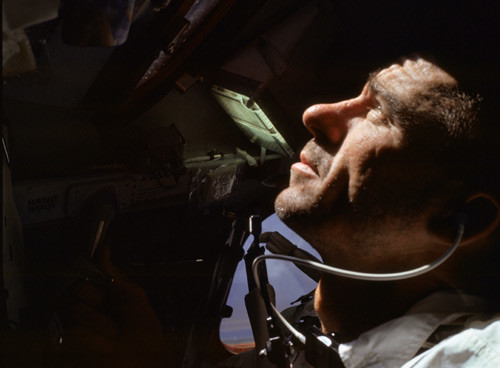
Eye on the sky: NASA astronaut Walter Cunningham during the Apollo 7 mission, in October 1968. (Courtesy: NASA)
By Tamela Maciel at the National Space Centre in Leicester
Last week, the planet Mars was under the international spotlight once more as NASA scientists announced that liquid water may still be flowing on the surface of the red planet. Also, the much-anticipated film adaptation of The Martian – a 2011 novel by American author Andy Weir – a science-driven story of human survival on Mars, hit the box office. Mars was also the hot topic at a recent event held at the National Space Centre in Leicester. The guest of honour was Apollo 7 astronaut Walter Cunningham and throughout the hour-long Q&A, he emphasized the need to push the “next frontier” and send humans to Mars.
Cunningham is not a man lacking in confidence or the experience of pushing boundaries. When asked if he ever felt the pressure of the astronaut selection or training process, he said “I thought I could fly anything, any time, anywhere. Was that true? I don’t know. But that’s how I felt.”
From fighter pilot to NASA astronaut, Cunningham went on to crew the very first Apollo mission in 1968 shortly after the Apollo 1 ground test ended tragically in fire. Apollo 7 flew for 11 days and orbited 163 times around the Earth, testing every part of the new command service module and completing the first US TV broadcast from space. Cunningham became the unofficial mission photographer when his right-seat window was one of the few that didn’t fog up due to a minor fault. Apollo 7 was critical in proving the capability of the capsule and, in many ways, its success paved the way for the Apollo 11 moon landing.
“There wasn’t one of us [the Apollo astronauts] who wasn’t convinced we would be on Mars within our lifetime. That was just the rate things were going,” he said. However, Cunningham believes that we have since lost the drive to push boundaries in space and this, according to him, has come at a big cost to our society.
Countless technological breakthroughs made during the Apollo era have filtered into our lives today, from accurate satellite weather forecasts to the mobile phones in our pockets. Medical advances in osteoporosis treatment, digital mammography and food nutrition are all direct results of ongoing space research. The cost of the Apollo project was more than 100 billion US dollars in today’s currency. Nevertheless, it is currently estimated that for every dollar invested in the space programme, between $8 and $10 dollars’ worth of derivative benefits are added to the economy. This is the real argument in favour of sending humans to Mars, according to Cunningham.
He also acknowledged that the basic science would be fascinating as there is much that we still do not know about Mars (as last week’s water discovery made clear), and that humans are far more efficient and creative than pre-programmed rovers. But above all, he argued that our society owes it to itself and to future generations to keep pushing the frontier, in order to reap the unknown benefits in innovation and discovery.
“There is an obligation by humanity to push the next frontier,” said Cunningham. “The world is as good as it is today because of this.” As Cunningham said at the beginning of the talk, “500 years from now, people will only remember only thing about the 20th century: that it was the century when man first left Earth.”
Trackback: Pushing towards the human–Martian frontier – MyPhysNet